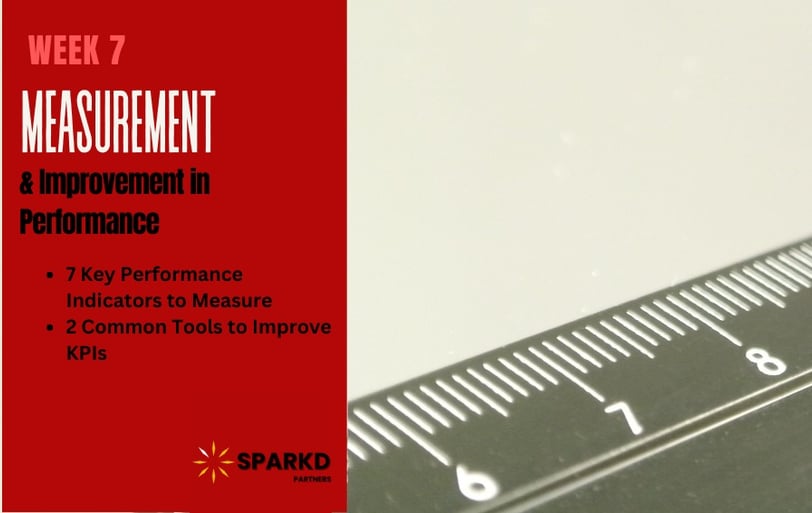Week 7: Performance Measurement and Improvement
Performance review and continuous improvement are essential for any business looking to improve and achieve its strategic objectives. By measuring and documenting key metrics, businesses can track their progress and identify areas for improvement, allowing them to optimize operations, reduce costs, and enhance customer satisfaction. Continuous improvement through regular performance reviews is important as it helps businesses identify areas for improvement and make necessary adjustments to their strategies and operations.


Measuring Supply Chain Performance (Part 1)
For the past 7 weeks, we’ve done a crash course about leadership and management to help you succeed when leading a supply chain team.
To close this series, we are sharing how you can measure your success, understanding your shortcomings and moving forward. For any business to improve, it needs to document and measure key metrics.
At the Annual Global CSCMP Conference in 2011, P&G revealed that while the company had hit all their internal metrics, their customers were measuring different metrics.
In order to keep in sync with their customers, P&G created SAMBC - Service As Measured By the Customer.
"Our customers' measurement becomes our measurement."
We believe that is a very important unit of measure because what is a business without it’s customers. Who are you serving if not them?
Organizations need to track their progress to ensure that they are moving towards achieving their strategic objectives. But how do you track your progress and more importantly what metrics should you be tracking? Not all metrics are created equal and choosing the correct metrics allow businesses to focus their efforts on key areas that have the greatest impact on their success.
For most businesses, it can be divided into two important parts:
Key Performance Indicators (KPIs): Internal metrics that measure the lead time, fill rate and cost affecting the company’s bottom line
Customer Success Indicators: Metrics that are important to customers and strategies you can apply to monitor and improve them
7 KPIs for Measuring Supply Chain Success
These 7 indicators help you evaluate your company’s performance and identify areas for improvement, enabling you to optimize operations, reduce costs, and enhance customer satisfaction. While there are some industry specific metrics like:
Retail Industry: Sell-through rate, weeks of supply, and gross margin return on investment (GMROI).
Manufacturing Industry: Production cycle time, throughput, and yield.
Healthcare Industry: Inventory accuracy, lead time for critical supplies, and stock-outs.
Food and Beverage Industry: Batch cycle time, fill rate, and order accuracy.
Technology Industry: New product introduction cycle time, order cycle time, and customer order lead time.
Our focus today is on supply chain metrics that assess the overall performance of the supply chain system. These metrics enable you to understand how well your supply chain is performing, identify bottlenecks, and optimize operations to improve reliability, speed, and cost-effectiveness.
Inventory Turns: The number of times inventory is sold and replaced in a given period.
Example: A retail company measures that its inventory turns 10 times per year, indicating that products are selling quickly and efficiently.
Order Fill Rate: The percentage of orders that are filled correctly and delivered on time.
Example: A manufacturing company measures that 98% of orders are filled correctly and delivered on time, indicating that they have a reliable and efficient supply chain.
Perfect Order Rate: The percentage of orders that are delivered without errors or defects.
Example: A distribution company measures that 95% of orders are delivered without errors or defects, indicating that they have effective quality control processes in place.
On-Time Delivery: The percentage of orders that are delivered on or before the promised delivery date.
Example: A transportation company measures that 90% of orders are delivered on or before the promised delivery date, indicating that they have a reliable and timely transportation system.
Cost Per Unit: The cost of producing and delivering a unit of product.
Example: A food manufacturer calculates that the cost per unit for a particular product is $5, indicating the efficiency of their production and supply chain processes.
Lead Time: The time it takes for a product to move through the supply chain, from order placement to delivery.
Example: An e-commerce retailer measures that it takes an average of 3 days for a product to be delivered to customers, indicating the efficiency of their supply chain processes.
Capacity utilization: the percentage of production capacity being used at a given time.
Example:For example, if a manufacturing company has a capacity of 10,000 units and produces 8,000 units, the capacity utilization is 80%.
Measuring and documenting key metrics is essential for any business to improve and achieve their strategic objectives.
Businesses need to focus on both Key Performance Indicators (KPIs) and Customer Success Indicators to monitor and improve their performance.
There are industry-specific metrics for different businesses, such as sell-through rate, production cycle time, inventory accuracy, and new product introduction cycle time.
7 KPIs for measuring supply chain success are inventory turns, order fill rate, perfect order rate, on-time delivery, cost per unit, lead time, and capacity utilization.
In the next part of this post, we cover some strategies you can adopt to continuously monitor and improve your supply chain. Read it here.


